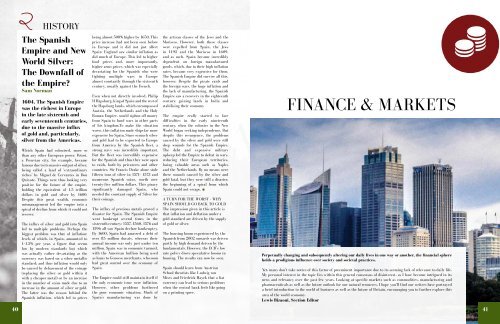The Future of Britain
Create successful ePaper yourself
Turn your PDF publications into a flip-book with our unique Google optimized e-Paper software.
HISTORY<br />
<strong>The</strong> Spanish<br />
Empire and New<br />
World Silver:<br />
<strong>The</strong> Downfall <strong>of</strong><br />
the Empire?<br />
Sam Norman<br />
1604. <strong>The</strong> Spanish Empire<br />
was the richest in Europe<br />
in the late sixteenth and<br />
early seventeenth centuries,<br />
due to the massive influx<br />
<strong>of</strong> gold and, particularly,<br />
silver from the Americas.<br />
Which Spain had colonised, more so<br />
than any other European power. Potosi,<br />
a Peruvian city, for example, became<br />
famous due to its massive output <strong>of</strong> silver,<br />
being called a land <strong>of</strong> ‘extraordinary<br />
riches’ by Miguel de Cervantes in Don<br />
Quixote. Things were thus looking very<br />
positive for the future <strong>of</strong> the empire,<br />
holding the equivalent <strong>of</strong> 1.5 trillion<br />
dollars in gold and silver by 1600.<br />
Despite this great wealth, economic<br />
mismanagement led the empire into a<br />
spiral <strong>of</strong> decline from which it could not<br />
recover.<br />
<strong>The</strong> influx <strong>of</strong> silver and gold into Spain<br />
led to multiple problems. Perhaps the<br />
biggest problem was that <strong>of</strong> inflation;<br />
levels <strong>of</strong> which, in Spain, amounted to<br />
1-1.5% per year, a figure that seems<br />
low by modern standards but which<br />
was actually rather devastating as the<br />
currency was based on a silver metallic<br />
standard; and thus inflation would only<br />
be caused by debasement <strong>of</strong> the coinage<br />
(replacing the silver or gold within it<br />
with a cheaper metal) or by an increase<br />
in the number <strong>of</strong> coins made due to an<br />
increase in the amount <strong>of</strong> silver or gold.<br />
<strong>The</strong> latter was the reason behind the<br />
Spanish inflation, which led to prices<br />
being almost 500% higher by 1650. This<br />
price increase had not been seen before<br />
in Europe and it did not just affect<br />
Spain- England saw similar inflation as<br />
did much <strong>of</strong> Europe. This led to higher<br />
food prices and, more importantly,<br />
higher arms prices, which was especially<br />
devastating for the Spanish who were<br />
fighting multiple wars in Europe<br />
almost constantly through the sixteenth<br />
century, usually against the French.<br />
Even when not directly involved, Philip<br />
II Hapsburg, king <strong>of</strong> Spain and the rest <strong>of</strong><br />
the Hapsburg lands, which encompassed<br />
Austria, the Netherlands and the Holy<br />
Roman Empire, would siphon <strong>of</strong>f money<br />
from Spain to fund wars in other parts<br />
<strong>of</strong> his kingdom.To make the situation<br />
worse, this inflation made ships far more<br />
expensive for Spain. Since so much silver<br />
and gold had to be exported to Europe<br />
from America by the Spanish fleet, a<br />
strong navy was incredibly important.<br />
But the fleet was incredibly expensive<br />
for the Spanish and thus they were open<br />
to raids, both by privateers and other<br />
countries. Sir Francis Drake alone stole<br />
fifteen tons <strong>of</strong> silver in 1571- 1573 and<br />
numerous Spanish coins, worth over<br />
twenty-five million dollars. This piracy<br />
significantly damaged Spain, who<br />
needed the constant supply <strong>of</strong> Silver for<br />
their coinage.<br />
<strong>The</strong> influx <strong>of</strong> precious metals proved a<br />
disaster for Spain. <strong>The</strong> Spanish Empire<br />
went bankrupt several times in the<br />
sixteenth century: 1557, 1560, 1576 and<br />
1596 all saw Spain declare bankruptcy.<br />
By 1600, Spain had amassed a debt <strong>of</strong><br />
over 85 million ducats, whereas their<br />
annual income was only just under ten<br />
million. Spain was in economic turmoil,<br />
with the American bullion being used<br />
as loans to Genoese merchants, who soon<br />
had great control over the economy <strong>of</strong><br />
Spain.<br />
<strong>The</strong> Empire could still maintain itself if<br />
the only economic issue were inflation.<br />
However, other problems furthered<br />
the poor economic situation. Much <strong>of</strong><br />
Spain’s manufacturing was done by<br />
the artisan classes <strong>of</strong> the Jews and the<br />
Moriscos. However, both these classes<br />
were expelled from Spain, the Jews<br />
in 1492 and the Moriscos in 1609,<br />
and as such, Spain became incredibly<br />
dependent on foreign manufactured<br />
goods, which, due to their high inflation<br />
rates, became very expensive for them.<br />
<strong>The</strong> Spanish Empire did survive all this,<br />
however. Despite the pirate raids and<br />
the foreign wars, the huge inflation and<br />
the lack <strong>of</strong> manufacturing, the Spanish<br />
Empire saw a recovery in the eighteenth<br />
century, gaining lands in India and<br />
stabilising their economy<br />
<strong>The</strong> empire really started to face<br />
difficulties in the early nineteenth<br />
century, when the colonies in the New<br />
World began seeking independence. But<br />
despite this resurgence, the problems<br />
caused by the silver and gold were still<br />
deep wounds for the Spanish Empire.<br />
<strong>The</strong> debt and expensive military<br />
upkeep led the Empire to defeat in wars,<br />
reducing their European territories,<br />
losing valuable areas such as Naples<br />
and the Netherlands. By no means were<br />
these wounds caused by the silver and<br />
gold fatal, but they were still a disaster,<br />
the beginning <strong>of</strong> a spiral from which<br />
Spain could not escape. ƒ<br />
________________________________<br />
A TURN FOR THE WORST - WHY<br />
SPAIN SHOULD GO BACK TO GOLD<br />
<strong>The</strong> impression given in this article is<br />
that inflation and deflation under a<br />
gold standard are driven by the supply<br />
<strong>of</strong> gold or silver.<br />
<strong>The</strong> housing boom experienced by the<br />
Spanish from 2002 onwards was driven<br />
partly by high demand driven by the<br />
fundamentals. However, the ECB’s low<br />
rate policy drove speculative booms in<br />
housing. <strong>The</strong> results can now be seen.<br />
Spain should learn from Austrian<br />
School theorists like Ludwig von<br />
Mises and Friedrick Hayek that a fiat<br />
currency can lead to serious problems<br />
when the central bank feels like going<br />
on a printing spree.<br />
FINANCE & MARKETS<br />
Perpetually changing and subsequently altering our daily lives in one way or another, the financial sphere<br />
holds a prodigious influence over society and societal practices.<br />
Yet, many don’t take notice <strong>of</strong> this factor <strong>of</strong> preeminent importance due to its seeming lack <strong>of</strong> relevance to daily life.<br />
My personal interest in the topic lies within this general consensus <strong>of</strong> disinterest, as I have become intrigued in its<br />
news and relevancy over the past few years. Looking at specific markets such as commodities, manufacturing and<br />
pharmaceuticals as well as the future outlook for our natural resources, I hope you’ll find our writers have portrayed<br />
a brief introduction to the world <strong>of</strong> business as well as the future <strong>of</strong> <strong>Britain</strong>, encouraging you to further explore this<br />
area <strong>of</strong> the world economy.<br />
Lewis Bizaoui, Section Editor<br />
40<br />
41




